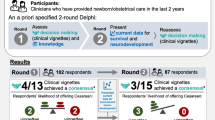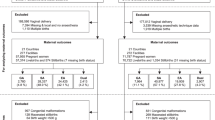Abstract
Objective:
Test the association between provider characteristics and antenatal interventions offered for periviable delivery.
Study Design:
Six hundred surveys mailed to members of the College's Collaborative Ambulatory Research Network. Items queried physicians' practices regarding administering steroids, recommending cesarean (for breech) and offering induction (for ruptured membranes) at 23 weeks.
Result:
Three hundred and ten (52%) obstetricians (OBs) responded. Respondents reported institutional cutoffs of 23 weeks for resuscitation (34%) and 24 weeks for cesarean (35%), whereas personal preferences for cesarean were ⩾25 weeks (44%). At 23 weeks, two-thirds ordered steroids, 43% recommended cesarean and 23% offered induction. In multivariable analyses, institutional cutoffs and providers' personal preferences predicted steroid administration (odds ratio, OR=4.37; 95% confidence interval, CI=1.73 to 11.00; OR=0.30, 95% CI=0.13 to 0.70); institutional cutoffs and the impression that cesarean decreases neurodevelopmental disability predicted recommending cesarean (OR=3.09, 95% CI=1.13 to 8.44; OR=6.41, 95% CI=2.06 to 19.91). For offering induction, practice location and religious service attendance approached, but did not meet, statistical significance (P=0.06 and P=0.05).
Conclusion:
OBs' willingness to intervene can impact periviable outcomes. These findings suggest that personal and institutional factors may influence obstetrical counseling and decision-making.
This is a preview of subscription content, access via your institution
Access options
Subscribe to this journal
Receive 12 print issues and online access
$259.00 per year
only $21.58 per issue
Buy this article
- Purchase on Springer Link
- Instant access to full article PDF
Prices may be subject to local taxes which are calculated during checkout


Similar content being viewed by others
References
Dworetz AR End of Life, at Birth. 2013 (cited 2014 March 28) Available from: http://www.nytimes.com/2013/08/05/opinion/end-of-life-at-birth.html?_r=0.
Kaempf JW, Tomlinson MW, Campbell B, Ferguson L, Stewart VT . Counseling pregnant women who may deliver extremely premature infants: medical care guidelines, family choices, and neonatal outcomes. Pediatrics 2009; 123 (6): 1509–1515.
Hintz SR, Kendrick DE, Wilson-Costello DE, Das A, Bell EF, Vohr BR et al. Early-childhood neurodevelopmental outcomes are not improving for infants born at <25 weeks' gestational age. Pediatrics 2011; 127 (1): 62–70.
Moore GP, Lemyre B, Barrowman N, Daboval T . Neurodevelopmental outcomes at 4 to 8 years of children born at 22 to 25 weeks' gestational age: a meta-analysis. JAMA Pediatr 2013; 167 (10): 967–974.
Petrou S, Mehta Z, Hockley C, Cook-Mozaffari P, Henderson J, Goldacre M . The impact of preterm birth on hospital inpatient admissions and costs during the first 5 years of life. Pediatrics 2003; 112 (6 Pt 1): 1290–1297.
Clements KM, Barfield WD, Ayadi MF, Wilber N . Preterm birth-associated cost of early intervention services: an analysis by gestational age. Pediatrics 2007; 119 (4): e866–e874.
Gilbert WM, Nesbitt TS, Danielsen B . The cost of prematurity: quantification by gestational age and birth weight. Obstet Gynecol 2003; 102 (3): 488–492.
Doron MW, Veness-Meehan KA, Margolis LH, Holoman EM, Stiles AD . Delivery room resuscitation decisions for extremely premature infants. Pediatrics 1998; 102 (3): 574–582.
Bastek TK, Richardson DK, Zupancic JA, Burns JP . Prenatal consultation practices at the border of viability: a regional survey. Pediatrics 2005; 116 (2): 407–413.
Sanders MR, Donohue PK, Oberdorf MA, Rosenkrantz TS, Allen MC . Perceptions of the limit of viability: neonatologists' attitudes toward extremely preterm infants. J Perinatol 1995; 15 (6): 494–502.
Partridge JC, Freeman H, Weiss E, Martinez AM, Kilpatrick S . Delivery room resuscitation decisions for extremely low birthweight infants in California. J Perinatol 2001; 21 (1): 27–33.
Tucker Edmonds B, Krasny S, Srinivas S, Shea J . Obstetric decision-making and counseling at the limits of viability. Am J Obstet Gynecol 2012; 206 (3): 248 e241–245.
Bottoms SF, Paul RH, Iams JD, Mercer BM, Thom EA, Roberts JM et al. Obstetric determinants of neonatal survival: influence of willingness to perform cesarean delivery on survival of extremely low-birth-weight infants. National Institute of Child Health and Human Development Network of Maternal-Fetal Medicine Units. Am J Obstet Gynecol 1997; 176 (5): 960–966.
Malloy MH . Impact of cesarean section on neonatal mortality rates among very preterm infants in the United States, 2000-2003. Pediatrics 2008; 122 (2): 285–292.
Deutsch A, Salihu HM, Lynch O, Marty PJ, Belogolovkin V . Cesarean delivery versus vaginal delivery: impact on survival and morbidity for the breech fetus at the threshold of viability. J Matern Fetal Neonatal Med 2010; 24 (5): 713–717.
Rasinski KA, Yoon JD, Kalad YG, Curlin FA . Obstetrician-gynaecologists' opinions about conscientious refusal of a request for abortion: results from a national vignette experiment. Journal of medical ethics 2011; 37 (12): 711–714.
Saigal S, Stoskopf BL, Feeny D, Furlong W, Burrows E, Rosenbaum PL et al. Differences in preferences for neonatal outcomes among health care professionals, parents, and adolescents. JAMA 1999; 281 (21): 1991–1997.
Reddy UM, Zhang J, Sun L, Chen Z, Raju TN, Laughon SK . Neonatal mortality by attempted route of delivery in early preterm birth. Am J Obstet Gynecol 2012; 207 (2): 117 e111–117 e118.
Deulofeut R, Sola A, Lee B, Buchter S, Rahman M, Rogido M . The impact of vaginal delivery in premature infants weighing less than 1,251 grams. Obstet Gynecol 2005; 105 (3): 525–531.
Wadhawan R, Vohr BR, Fanaroff AA, Perritt RL, Duara S, Stoll BJ et al. Does labor influence neonatal and neurodevelopmental outcomes of extremely-low-birth-weight infants who are born by cesarean delivery?. Am J Obstet Gynecol 2003; 189 (2): 501–506.
Rothman KJ . No adjustments are needed for multiple comparisons. Epidemiology (Cambridge, Mass) 1990; 1 (1): 43–46.
Acknowledgements
Financial Support: This publication was made possible in part by Grant Number KL2 TR000163 (A. Shekhar, PI) from the National Institutes of Health, National Center for Advancing Translational Sciences, Clinical and Translational Sciences Award and the Robert Wood Johnson Foundation's Amos Medical Faculty Development Program. This paper was also supported by Grant Number R60MC 05674 from the Maternal and Child Health Bureau (Title V, Social Security Act, Health Resources and Services Administration, and Department of Health and Human Services (DHHS)).
Author information
Authors and Affiliations
Corresponding author
Ethics declarations
Competing interests
The authors declare no conflict of interest.
Rights and permissions
About this article
Cite this article
Tucker Edmonds, B., McKenzie, F., Farrow, V. et al. A national survey of obstetricians' attitudes toward and practice of periviable intervention. J Perinatol 35, 338–343 (2015). https://doi.org/10.1038/jp.2014.201
Received:
Revised:
Accepted:
Published:
Issue Date:
DOI: https://doi.org/10.1038/jp.2014.201
This article is cited by
-
Diverse perspectives on death, disability, and quality of life: an exploratory study of racial differences in periviable decision-making
Journal of Perinatology (2021)
-
The Mortality of Periviable and Extremely Premature Infants and Their Impact on the Overall Neonatal Mortality Rate
Scientific Reports (2020)
-
Neonatology in Austria: ethics to improve practice
Medicine, Health Care and Philosophy (2020)
-
Decision-making at the limit of viability: the Austrian neonatal choice context
BMC Pediatrics (2019)
-
Prenatal (non)treatment decisions in extreme prematurity: evaluation of Decisional Conflict and Regret among parents
Journal of Perinatology (2017)



